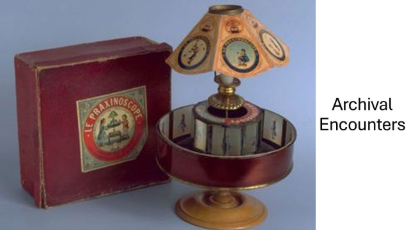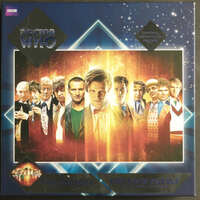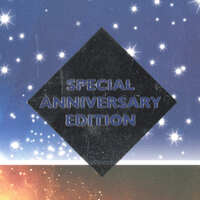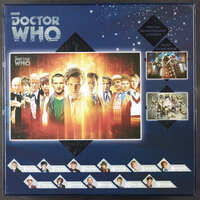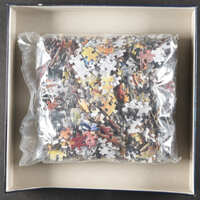Doctor Who Special Anniversary jigsaw
Dublin Core
Title
Doctor Who Special Anniversary jigsaw
Subject
Doctor Who
Description
‘Doctor Who Special Anniversary Jigsaw’ (BDCM 66958) is a 1000-piece jigsaw puzzle that was commissioned to be made in order to celebrate the shows 50th anniversary. The jigsaw celebrates the many different actors who have played the doctor throughout its long running show. Booth and others write that “The perennially popular BBC series holds a unique place in the history of television: as the longest-running science-fiction series, academic research and fan discussion about the show track social and cultural changes over the past sixty years.” (1). As we can see from this argument, Doctor Who is canonical show in the history of not only science fiction television, but also of general television history. Therefore, when the show reached its 50th anniversary, it was a moment to celebrate. They did this in many ways such as special episode that was titled “The Day of the Doctor” (2013). Another way they did this is through this artefact which draws upon the nostalgia of the series for fans.
The Jigsaw itself is made up of 1000 pieces which when put together form a picture which depicts the different actors who have played Dr Who. This ranges from the very first doctor, played by William Hartnell from 1963-1966 all the way up to the most recent doctor (of the time) who was played by Matt Smith. The box contains the final image of the jigsaw puzzle. On the back of the puzzle, there are small pictures of each doctor containing information on what doctor they were (first, second etc..) and the time period which they portrayed that doctor. This artefact is a good source for gaining information about the who has played Doctor Who as well as representing the legacy of the franchise. Also on the back of the puzzle, there are pictures of some of the other puzzles that are available to buy. This includes one puzzle with many images of the Daleks and another which is a compilation of other iconic villains seen across the franchise such as the Cybermen. Therefore, this puzzle acts as a form of advertising for similar ancillary products related to the franchise that are also available.
Freeman writes that “These Tarzan jigsaw puzzles, produced as extensions of the Tarzan brand as manifested across multiple media, all became just another match box to be collected.” (52). Although Freeman is writing about jigsaws in relation to the Tarzan radio serial that was released in the 1930’s, I believe we can still apply these ideas here. Freeman argues that the Jigsaw puzzle acts in two ways: an extension of the brand and another item to be collected. I believe that this is the case for this jigsaw. It acts as an extension of the brand of Doctor Who because it is another ancillary product to accompany the line of many other ancillary products available such as action figures, models and much more. As well as this, the jigsaw also acts as a collector’s item for a fan of the franchise. As this item was commissioned especially to celebrate the shows 50th anniversary, it becomes a piece of history which fans of the franchise want to engage with.
One potential way to view this artefact is to view it as a piece of fan memorabilia which fans can use to interact with the franchise. Booth and Jones write that “As fans expound on their particular favourites or least-favourites, they bring a sense of propriety to the media texts of which they are part. We’re concentrating on Doctor Who fandom in particular in this book, not only because Doctor Who fans (nicknamed ‘Whovians’ by the Doctor Who Fan Club of America in the 1980s – a term that itself is devalued by many Classic Doctor Who fans) are notorious for rankings, best-of lists, worst-of lists, and polls about the most fill-in-the-blank-attribute of the series, but also because we ourselves are part of this fan culture, a positionality we interrogate in more detail in the conclusion.” (1-2). Their argument suggests that fandoms become groups which establish a hierarchy based on how much knowledge you may possess about the franchise. As well as this, they argue that hierarchies are created through taste, for example what is your favourite episode or favourite Doctor. Therefore, I believe this artefact links in with the fan culture because it brings a sense of togetherness; everyone can engage with the puzzle because it depicts doctors from across the franchise, meaning there is something for everyone. The puzzle acts as a way of breaking down the hierarchies present within the fan community and unifying them under the umbrella that they are all Doctor Who fans despite what their personal taste’s may be.
Another way that this puzzle fits into the fan community is through the element of nostalgia. Jacobsen writes that “Throughout history, humans have always attempted not only to anticipate and shape the future, but also to make sense of and relate to the/ their past. The past is often regarded as the already known territory, whereas the future is regarded as an alien and sometimes even scary terrain. Time, however, is a tricky thing. What we may think we already know well and have left behind us long ago sometimes returns to haunt and pester us – even many years after its actual occurrence. At other times, the re- acquaintance with or revisits to the past – voluntary and involuntary – are much more pleasurable and positive.” (1). Jacobsen writes that nostalgia is a common human emotion that can evoke a variation of feelings. In relation to Doctor Who, Phillips writes that “Recollections of childhood experience are, inevitably, caught in the filters of adulthood – knowledge added, subtracted, modified, warped – and so when I think about my earliest awareness of Doctor Who, the white and the brown curls of my ‘original’ Doctors becomes entangled with prior and subsequent Time Lord hairstyles, from the long silver wig of the First Doctor to the floppy ‘not ginger fringe of the Eleventh.” (17). Pairing these two arguments together, this can give us a whole new way to view the jigsaw puzzle: as a piece of nostalgia. This is obviously audience dependent however by bringing together all of the Doctors, this creates a sense of nostalgia for fans who can reminisce about memories they have of the early stages of the franchise whilst engaging with the puzzle. Therefore, this puzzle anchors and unlocks the fans memories.
The Whoniverse was created, as stated by the BBC website, as a “official name, and dedicated home, for all shows within the orbit of Doctor Who.” (Welcome to the Whoniverse...and Tales of the Tardis). Hills writes that “…the ‘Whoniverse’ referred to then-televised episodes as well as Doctor Who’s producers and fan clubs. More recently, the 'Whoniverse' has meant the show’s overarching diegetic universe…” (344-345). I want to argue that this jigsaw is a key part of the ‘Whoniverse’. First of all, it ties together all of the different Doctors into one jigsaw, which is a physical engagement of the franchise being brought together. As well as this, the puzzle also acts as a route into the ‘Whoniverse’ for fans who may have joined the franchise at different moments in time. By being able to see all of the Doctors, it acts as a route into the different universes that form together the wider universe. This is futher reinforced by the fact that this was commissioned as part of the anniversary of the franchise, which encourages fans to go back, engage and celebrate the ‘Whoniverse’.
Works Cited:
BBC. "Welcome to the Whoniverse...and Tales of the Tardis." BBC Doctor Who. October 30th 2023, https://www.doctorwho.tv/news-and-features/welcome-to-the-whoniverse-and-tales-of-the-tardis.
Booth, Paul, Matt Hills , Joy Piedmont , and Tansy Rayner Roberts. "Introduction." Adventures Across Space and Time: A Doctor Who Reader. Ed. Paul Booth , Matt Hills , Joy Piedmont and Tansy Rayner Roberts London,: Bloomsbury Academic, 2023. 1–8. Bloomsbury Collections. Web. 4 Dec. 2024. <http://dx.doi.org/10.5040/9781350288416.ch-I>.
Booth, Paul , and Craig Owen Jones. "Introduction Going Forward in All Our Beliefs: Regenerating and Re-Valuation in Doctor Who Fandom." Watching Doctor Who: Fan Reception and Evaluation. London: Bloomsbury Academic, 2020. 1–16. Who Watching. Bloomsbury Collections. Web. 5 Dec. 2024. <http://dx.doi.org/10.5040/9781350116757.ch-001>.
Freeman, Matthew. "The Wonderful Game of Oz and Tarzan Jigsaws: Commodifying Transmedia in Early Twentieth-Century Consumer Culture ." Intensities: The Journal of Cult Media, issue 7, August 2014 , pp. 44-54.
Hills, Matt. “Traversing the ‘Whoniverse’: Doctor Who’s Hyperdiegesis and Transmedia Discontinuity/Diachrony.” World Building, edited by Marta Boni, Amsterdam University Press, 2017, pp. 343–61. JSTOR, https://doi.org/10.2307/j.ctt1zkjz0m.22. Accessed 6 Dec. 2024.
Jacobsen, Michael Hviid. “Introduction: The Many Different Faces of Nostalgia – Exploring a Multifaceted and Multidisciplinary Emotion.” Intimations of Nostalgia: Multidisciplinary Explorations of an Enduring Emotion, edited by Michael Hviid Jacobsen, 1st ed., Bristol University Press, 2022, pp. 1–30. JSTOR, https://doi.org/10.2307/j.ctv21zp21b.5. Accessed 5 Dec. 2024.
Phillips, Ivan. "Frock Coats, Yo-Yos and a Chair with a Panda on it: Nostalgia for the Future in the Life of a Doctor Who Fan." Fan Phenomena: Doctor Who, edited by Paul Booth, Intellect Books, 2013, pp. 17-27.
The Bill Douglas Cinema Museum. "Doctor Who Special Anniversary jigsaw." The Bill Douglas Cinema Museum. https://www.bdcmuseum.org.uk/explore/item/66958/. Date Accessed 13th December 2024
"The Day of the Doctor." Doctor Who, created by Steven Moffat, series 7, episode 16, BBC One Television, 23rd November 2013.
Tarzan, WOR, 1932-1936.
The Jigsaw itself is made up of 1000 pieces which when put together form a picture which depicts the different actors who have played Dr Who. This ranges from the very first doctor, played by William Hartnell from 1963-1966 all the way up to the most recent doctor (of the time) who was played by Matt Smith. The box contains the final image of the jigsaw puzzle. On the back of the puzzle, there are small pictures of each doctor containing information on what doctor they were (first, second etc..) and the time period which they portrayed that doctor. This artefact is a good source for gaining information about the who has played Doctor Who as well as representing the legacy of the franchise. Also on the back of the puzzle, there are pictures of some of the other puzzles that are available to buy. This includes one puzzle with many images of the Daleks and another which is a compilation of other iconic villains seen across the franchise such as the Cybermen. Therefore, this puzzle acts as a form of advertising for similar ancillary products related to the franchise that are also available.
Freeman writes that “These Tarzan jigsaw puzzles, produced as extensions of the Tarzan brand as manifested across multiple media, all became just another match box to be collected.” (52). Although Freeman is writing about jigsaws in relation to the Tarzan radio serial that was released in the 1930’s, I believe we can still apply these ideas here. Freeman argues that the Jigsaw puzzle acts in two ways: an extension of the brand and another item to be collected. I believe that this is the case for this jigsaw. It acts as an extension of the brand of Doctor Who because it is another ancillary product to accompany the line of many other ancillary products available such as action figures, models and much more. As well as this, the jigsaw also acts as a collector’s item for a fan of the franchise. As this item was commissioned especially to celebrate the shows 50th anniversary, it becomes a piece of history which fans of the franchise want to engage with.
One potential way to view this artefact is to view it as a piece of fan memorabilia which fans can use to interact with the franchise. Booth and Jones write that “As fans expound on their particular favourites or least-favourites, they bring a sense of propriety to the media texts of which they are part. We’re concentrating on Doctor Who fandom in particular in this book, not only because Doctor Who fans (nicknamed ‘Whovians’ by the Doctor Who Fan Club of America in the 1980s – a term that itself is devalued by many Classic Doctor Who fans) are notorious for rankings, best-of lists, worst-of lists, and polls about the most fill-in-the-blank-attribute of the series, but also because we ourselves are part of this fan culture, a positionality we interrogate in more detail in the conclusion.” (1-2). Their argument suggests that fandoms become groups which establish a hierarchy based on how much knowledge you may possess about the franchise. As well as this, they argue that hierarchies are created through taste, for example what is your favourite episode or favourite Doctor. Therefore, I believe this artefact links in with the fan culture because it brings a sense of togetherness; everyone can engage with the puzzle because it depicts doctors from across the franchise, meaning there is something for everyone. The puzzle acts as a way of breaking down the hierarchies present within the fan community and unifying them under the umbrella that they are all Doctor Who fans despite what their personal taste’s may be.
Another way that this puzzle fits into the fan community is through the element of nostalgia. Jacobsen writes that “Throughout history, humans have always attempted not only to anticipate and shape the future, but also to make sense of and relate to the/ their past. The past is often regarded as the already known territory, whereas the future is regarded as an alien and sometimes even scary terrain. Time, however, is a tricky thing. What we may think we already know well and have left behind us long ago sometimes returns to haunt and pester us – even many years after its actual occurrence. At other times, the re- acquaintance with or revisits to the past – voluntary and involuntary – are much more pleasurable and positive.” (1). Jacobsen writes that nostalgia is a common human emotion that can evoke a variation of feelings. In relation to Doctor Who, Phillips writes that “Recollections of childhood experience are, inevitably, caught in the filters of adulthood – knowledge added, subtracted, modified, warped – and so when I think about my earliest awareness of Doctor Who, the white and the brown curls of my ‘original’ Doctors becomes entangled with prior and subsequent Time Lord hairstyles, from the long silver wig of the First Doctor to the floppy ‘not ginger fringe of the Eleventh.” (17). Pairing these two arguments together, this can give us a whole new way to view the jigsaw puzzle: as a piece of nostalgia. This is obviously audience dependent however by bringing together all of the Doctors, this creates a sense of nostalgia for fans who can reminisce about memories they have of the early stages of the franchise whilst engaging with the puzzle. Therefore, this puzzle anchors and unlocks the fans memories.
The Whoniverse was created, as stated by the BBC website, as a “official name, and dedicated home, for all shows within the orbit of Doctor Who.” (Welcome to the Whoniverse...and Tales of the Tardis). Hills writes that “…the ‘Whoniverse’ referred to then-televised episodes as well as Doctor Who’s producers and fan clubs. More recently, the 'Whoniverse' has meant the show’s overarching diegetic universe…” (344-345). I want to argue that this jigsaw is a key part of the ‘Whoniverse’. First of all, it ties together all of the different Doctors into one jigsaw, which is a physical engagement of the franchise being brought together. As well as this, the puzzle also acts as a route into the ‘Whoniverse’ for fans who may have joined the franchise at different moments in time. By being able to see all of the Doctors, it acts as a route into the different universes that form together the wider universe. This is futher reinforced by the fact that this was commissioned as part of the anniversary of the franchise, which encourages fans to go back, engage and celebrate the ‘Whoniverse’.
Works Cited:
BBC. "Welcome to the Whoniverse...and Tales of the Tardis." BBC Doctor Who. October 30th 2023, https://www.doctorwho.tv/news-and-features/welcome-to-the-whoniverse-and-tales-of-the-tardis.
Booth, Paul, Matt Hills , Joy Piedmont , and Tansy Rayner Roberts. "Introduction." Adventures Across Space and Time: A Doctor Who Reader. Ed. Paul Booth , Matt Hills , Joy Piedmont and Tansy Rayner Roberts London,: Bloomsbury Academic, 2023. 1–8. Bloomsbury Collections. Web. 4 Dec. 2024. <http://dx.doi.org/10.5040/9781350288416.ch-I>.
Booth, Paul , and Craig Owen Jones. "Introduction Going Forward in All Our Beliefs: Regenerating and Re-Valuation in Doctor Who Fandom." Watching Doctor Who: Fan Reception and Evaluation. London: Bloomsbury Academic, 2020. 1–16. Who Watching. Bloomsbury Collections. Web. 5 Dec. 2024. <http://dx.doi.org/10.5040/9781350116757.ch-001>.
Freeman, Matthew. "The Wonderful Game of Oz and Tarzan Jigsaws: Commodifying Transmedia in Early Twentieth-Century Consumer Culture ." Intensities: The Journal of Cult Media, issue 7, August 2014 , pp. 44-54.
Hills, Matt. “Traversing the ‘Whoniverse’: Doctor Who’s Hyperdiegesis and Transmedia Discontinuity/Diachrony.” World Building, edited by Marta Boni, Amsterdam University Press, 2017, pp. 343–61. JSTOR, https://doi.org/10.2307/j.ctt1zkjz0m.22. Accessed 6 Dec. 2024.
Jacobsen, Michael Hviid. “Introduction: The Many Different Faces of Nostalgia – Exploring a Multifaceted and Multidisciplinary Emotion.” Intimations of Nostalgia: Multidisciplinary Explorations of an Enduring Emotion, edited by Michael Hviid Jacobsen, 1st ed., Bristol University Press, 2022, pp. 1–30. JSTOR, https://doi.org/10.2307/j.ctv21zp21b.5. Accessed 5 Dec. 2024.
Phillips, Ivan. "Frock Coats, Yo-Yos and a Chair with a Panda on it: Nostalgia for the Future in the Life of a Doctor Who Fan." Fan Phenomena: Doctor Who, edited by Paul Booth, Intellect Books, 2013, pp. 17-27.
The Bill Douglas Cinema Museum. "Doctor Who Special Anniversary jigsaw." The Bill Douglas Cinema Museum. https://www.bdcmuseum.org.uk/explore/item/66958/. Date Accessed 13th December 2024
"The Day of the Doctor." Doctor Who, created by Steven Moffat, series 7, episode 16, BBC One Television, 23rd November 2013.
Tarzan, WOR, 1932-1936.
Creator
RMS UK Ltd and BBC
Source
Doctor Who: 'The Day of the Doctor' - series 7 episode 16 (2013)
Publisher
RMS UK Ltd
Date
2013
Contributor
BBC
Rights
BBC, DOCTOR WHO (word marks, logos and devices). TARDIS, DALEKS, CYBERMEN and K-9 (work marks and devices) are trade marks of the British Broadcasting Corporation and are used under licence. BBC LOGO copyright BBC 1996. Doctor Who logo copyright BBC 2012. Dalek image copyright BBC/Terry Nation 1963. Cybermen image copyright BBC/Kit Pedler/Gerry Davis 1966. K-9 image copyright BBC/Bob Baker/Dave Martin 1977. Licensed for RMS UK Ltd
Format
Jigsaw Puzzle in a Cardboard Box - Box dimensions - 30 x 30 x 5.4 cm Puzzle Size - 73 x 38.5 cm
Language
English
Type
Jigsaw puzzle, Toy
Identifier
BDCM 66958
Coverage
Doctor Who, British Television, Science Fiction
Collection
Citation
RMS UK Ltd and BBC, “Doctor Who Special Anniversary jigsaw,” Archival Encounters: Digital Exhibitions form the Bill Douglas Cinema Museum, accessed July 12, 2025, https://humanities-research.exeter.ac.uk/archivalencounters/items/show/46.
